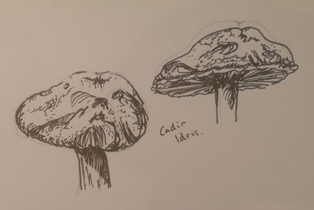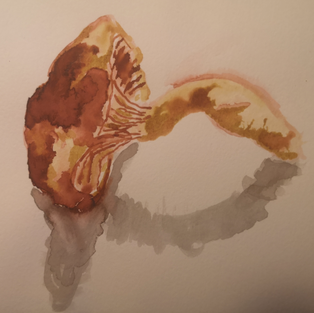A menagerie of mushrooms.
- Katie Rose

- Dec 8, 2019
- 3 min read
Alongside my degree studies, I signed up for one of the Lifelong Learning (LLL) courses offered by Aberystwyth University, Fungi: Natural History Illustration led by Tereska Shepard. It was delivered through 3 4-hour long sessions across 3 months (October, November, and December) and included teachings in mediums such as charcoal, ink and brush, fine-liner pens, and watercolours with the options to use any other materials you might desire.
Subjects were provided to draw from life by both Tereska and other students who had been foraging before the classes. We were provided with fungi of all different kinds: the classic parasol shape everyone thinks of, and within that umbrella there were fungi of varying gill patterns, stems and caps; earth-ball fungi more often with pores and holes as opposed to gills for spore release; bracket fungi, sometimes attached to the logs or branches they grew out of, sometimes separated and given only in the context of themselves.
During these sessions I have learnt so much, and although the artistic skills were delivered in only the context of illustrating fungi, they will be transferable to other subject and mediums. I had not once used watercolour paints before these sessions, sticking mainly to acrylic with some oil painting in there too, so this was a challenge for me, but a welcome one. I was so excited to try something new when I was buying the colours of paint listed on the materials hand out that I ended up buying more than what was listed because I knew even if I wasn't going to use them all when painting the fungi, I surely wasn't going to let them go to waste. When we first started to use the paints in the second session I was incredibly apprehensive because although I hadn't used watercolours before, everyone else in attendance had, and some extensively, so was worried I would end up looking foolish and somehow 'undeserving' of my status as a third year fine art student, but these feelings quickly melted away as I became focused on watching the paints move and blend on the page. Tereska spoke to us about how we should use the water pools on the page with gravity to our advantage, holding the paper up and turning it to get the coloured drops to move and blend in the way we wanted. This I found particularly pleasing when it came to adding the shadows to the stems of the fungi.
Whilst obviously this course was centered and focused around the illustration of the fungi subjects, I also managed to brush up on some of my fungi identification with Tereska and my fellow students. I had taken my copy of 'Food For Free' by Richard Mabey (a gift from my father) with me to all sessions, and other classmates had brought various other identification books, some full illustration some full images and some were a mixture of the two. The illustrations of these fungi were particularly useful as artist and method research, whilst the pictured images were helpful in that it gave me something to draw from without limiting my subjects to either re-drawings or only fungi found in this particular area of Wales during this particular time of year.
Overall I have thoroughly enjoyed this course, partly because it was building on an interest and passion I already had - that being all things outdoors and nature - whilst also giving me an opportunity to strengthen artistic skills I already had as well as learn some new techniques in a medium I had never touched before. If I find I have the time to in amongst all my studies in the new year, I would love to sign up for Tereska's next LLL course Natural History Illustration: Seaweed as I feel it will hit the same notes and interests as this fungi one did.
I have included some pictures of a few of the pieces I have produced within these classes (some finished, some not, and some pre-painting sketches too), but due to the hand-in date for the visual diary marked portion of this course being the 30th of January, I have completed and will complete many more outside of class hours.






















Comments